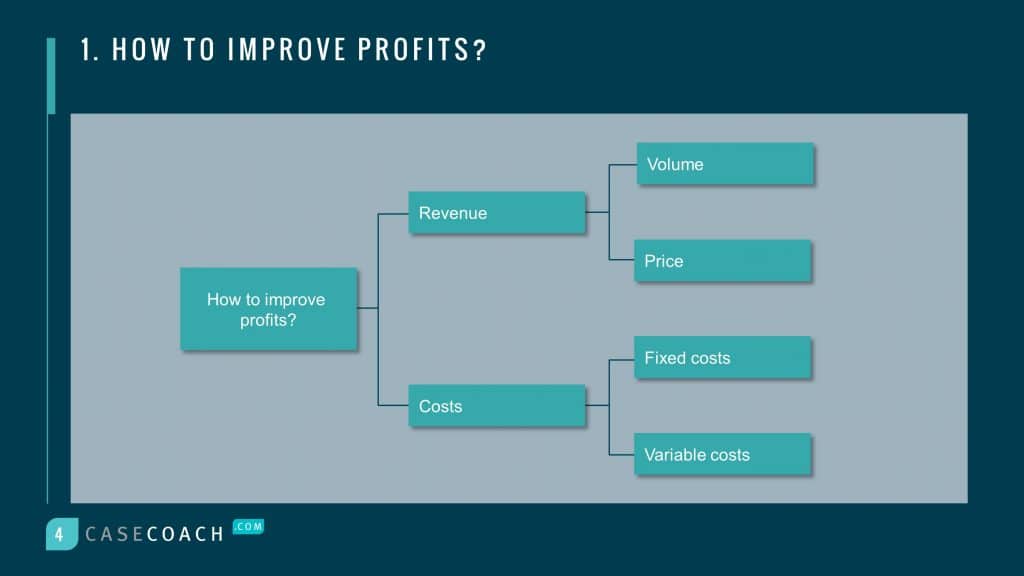
It’s easy to fall into the framework trap when preparing for the case interview. Many case books recommend learning and applying standard frameworks, but this won’t work. Consulting firms are increasingly using case questions that cannot be easily categorized. Standard cookie-cutter frameworks won’t help. So, how do you prepare yourself for all eventualities? You learn how to expertly structure a case from scratch!
In this article, we share an overview of how to structure five of the most common case questions. This is just a small snapshot of the structuring techniques we teach in our Interview Prep Course, where we go into much more depth not only on these five case questions but also on five additional case types, including how to structure any kind of off-the-wall case question. If you want to learn how to structure properly right away, you can sign up for the course here.
The mother of all case questions: profit improvement
In its simplest form, profit is revenue minus cost, as shown below. If you were looking to improve the profits of a business with several units or locations, you will likely want to look at the profitability of each part of the business separately, so you can eliminate the parts that are losing money.

For example, your client might be a winemaker who wants to increase their profit. In this case, revenue is the number of bottles sold multiplied by the price of a bottle. And the cost is the sum of the client’s costs associated with growing and harvesting the grapes, ageing and bottling the wine, distributing the product, and the overhead, including sales and marketing.
If the winemaker is producing several types of wines, you’d start by determining the profitability of each product and discontinue loss-making wines. Only once you’ve done that, would you look at opportunities to increase revenue or decrease costs across the business. The key here is to consider each of the levers that contribute to profit and to increase or decrease them to drive profit up.
Growing a business
There are two ways to grow a business. One is to grow within the core business. The second is to grow outside the core business. In other words, you can grow by selling more of what you have or by selling something new. A good framework for a case question on business growth will take this nuance into account.
There are multiple options within both of these branches, so choosing the applicable avenues to mention are key. For example, you can grow within the core by either growing within your current market segments or by identifying and focusing on the fastest growing segments in the market. You can also either increase the total spent per customer or increase the number of customers. Which options you choose to include in your framework will depend on your client and their market, so make sure each option is relevant.

Cost reduction
In our profit improvement framework, we listed the main cost categories. However, this approach doesn’t tell you how you can buy less and how you can buy for cheaper. The framework below is a more helpful way to think about it. If you want to reduce costs there are three ways to do so.

For example, if the case question was on reducing food cost in a restaurant, reducing the need could mean removing the dishes with the most expensive ingredients from the menu or reducing portion size. Meeting the need with less resources could be better planning to reduce waste. And reducing the cost of resources might mean finding cheaper suppliers.
How to enter a new market
For a case question on market entry, there are four drivers to consider: How big is the market opportunity? What kind of share of that market can we capture? Assuming that we capture that share, how much profit will we make? And finally, if it’s attractive, what are our capabilities and the risks involved to determine if we can actually make it happen.

Imagine your client is a soft drinks company who wants to enter the energy drinks market. First, you would look at the size and growth of the market, probably in different countries. Second, you would try to distinguish whether you can win in that market by considering if there are already some established players. One thing to consider here would be whether these players are fully meeting customer needs. For example, maybe customers would like a healthy energy drink option. Then the question becomes, do we have the right brand to legitimately sell this product?
If you do, this could have potential. In that case, you calculate the potential profit. At this stage you should have a view of the revenue, so you only need to look at costs, e.g., the investment to create the brand and the cost of manufacturing and distributing the product.
Finally, for capabilities and risks, you can consider regulatory risk, impact on other products, and supply chain capacity, among other things.
How to launch a new product
A new product launch question can be broken down into three steps: choose your target market segment, define your strategy to win in that segment, and, finally, execute. In order to choose the best target segment, compare different segments in terms of size, growth, competition, and customer needs, then pick the one most attractive for the client.
To define your strategy, a good approach is to use is the four Ps framework, which includes product features, price, place (distribution), and promotion (branding and advertising). A good answer would include a definition of these four elements in a way that will allow the client to win in the selected target segment. And finally, implementation, where a list should be built out of the things that need to happen for the client to launch the product.

For example, your client might be a sports brand that wants to launch a line of golf clubs. You determine that the most attractive segment is premium golf clubs for young players in Asia. Given that segment, you’ll want to design sleek products in the latest lightweight material, use a high price, distribute them to the Pro Shops of the courses that have a youth training academy, and build the brand by partnering with the golfers who have the most followers on social media. And finally, in terms of implementation, the client would need to think about how easy it is to establish a network of distributors in Asia.
Subscribe to CaseCoach
This is just a quick whistle-stop tour of just five of the ten case types we cover in much more depth within the Structuring Lectures of our Interview Prep Course. The other five case types are Pricing, Acquisition, Investment, Competitive Threat and Process Optimisation.
Plus, unlike many case preparation courses, we teach our students how to structure the completely random cases that don’t fit into any conventional frameworks. And, the course includes unique Structuring Drills to help you hone your skills.
If you want all our structuring strategies so you’re fully prepared for any case type, no matter how obscure, sign up to our Interview Prep Course here.






